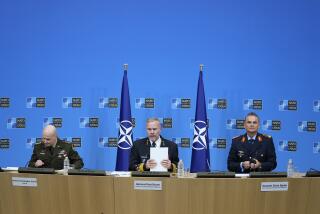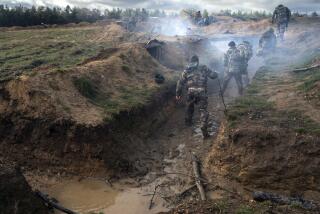U.S. War Games Send a Loud Message to Iraq
UDAIRI RANGE, Kuwait — The American firepower arrayed within earshot of Iraq on Wednesday morning was designed to overwhelm. More than 40 tanks and fighting vehicles lined up across the desert in attack formation, with self-propelled howitzers behind and helicopter gunships and screeching F-16s above.
When the attack began, it deafened: knee-buckling flashes of orange fire from 120-millimeter laser-ranged tank rounds, whistling barrages of 155-millimeter artillery shells, thumping .50-caliber machine guns and bombs from unseen jets.
Sand-filled dumpsters disguised as Iraqi tanks and pop-up plywood Iraqi soldiers met their fate as targets.
It was a war game, part of regularly scheduled training in northern Kuwait. It is meant as practice for U.S. forces. But the timing and location of the live-fire exercise by the U.S. Army’s 2nd Brigade, 1st Battalion, 64th Armor, also was meant to send a message next door that was loud, clear and all too real.
United Nations weapons inspectors are now in Iraq, which faces a weekend deadline for a crucial declaration detailing its weapons programs. With Wednesday’s exercises, the U.S. military was backing President Bush’s words of warning that Iraq must come clean -- and offering a demonstration of the alternative if it doesn’t.
“Literally, it’s like a pistol, and the hammer is cocked,” 2nd Brigade commander Col. David Perkins said on the mock battlefield.
From vast forward bases bristling with advanced satellite gear, air-conditioned troop tents and even color TV in the northern desert, to new ammunition depots, Mylar-windowed barracks and warehouses longer than a football field south of Kuwait City, the U.S. military has quietly put in place the logistics and much of the firepower to invade Iraq.
The U.S. Navy’s 5th Fleet has a full aircraft-carrier battle group in the Persian Gulf nearby, launching daily sorties that are bombing air defenses in southern Iraq.
Airfields from the tip of the Arabian Peninsula in Oman to the Gulf nations of Qatar, Saudi Arabia, Bahrain and Kuwait have squadrons of U.S. fighter jets and other attack aircraft with room for many more.
All that’s missing are two or three divisions of troops and their personal support equipment, which military sources and analysts say could be shuttled into Kuwait City’s international airport via civilian jetliners within a few weeks, at most.
So far, there are slightly more than 12,000 American military personnel in Kuwait -- double the usual presence, yet thousands of soldiers shy what would be needed for an invasion. There are more than 44,000 American military personnel in the Mideast and Central Asia, up from an average of between 20,000 to 25,000 in the last six years.
Most are here for training, war games that include a first-ever, command-and-control test run in the region scheduled to begin with force commander Gen. Tommy Franks at the helm of a new, state-of-the-art mobile headquarters in Qatar next week. The facility, designed to be deployable to any U.S. base in the region, uses sophisticated computer and communications equipment to allow commanders around the world to manage and monitor military activity in real time.
In Kuwait, a strategic staging ground for any land assault on Iraq, the U.S. military’s buildup has been largely material -- thousands of tons of hardware and the world’s most sophisticated software in secretive bases throughout the desert.
So massive is that presence on Iraq’s southern doorstep that it covers more than 1,600 square miles -- larger than a quarter of Kuwait, which is the size of New Jersey.
It is the fruit of hundreds of millions of dollars in construction, financed mostly by Kuwait in the last three years, and a flotilla of cargo ships that quietly has brought hundreds of tanks, artillery pieces and armored fighting vehicles.
A fraction of that materiel is being used by the U.S. Army’s 2nd Brigade, 3rd Infantry Division, out of Ft. Stewart, Ga., in the ongoing Army exercise dubbed Desert Spring -- nearly 4,000 officers who would be at the knife’s edge of any U.S. invasion.
The brigade, which calls itself “the tip of the spear of the American military,” arrived in September, the latest to rotate into exercises that date back several years.
The brigade is scheduled to remain here until March and in interviews during the last week at their remote, heavily fortified bases and in the field, the officers and enlisted men made it clear they have thought often and deeply about fighting Iraq.
“I say bring it on. If we’re going to do it, let’s do it,” said Maj. Rick Nussio of the 64th Armor tank battalion. “Everybody hopes it’s solved peacefully, but if it’s not, we’re here to do a job. And we’re ready to do it.”
After Wednesday’s live-fire games, Command Sgt. Maj. William Barnello said of his troops: “The guys are coming into their own now. They’re right where we want them. They’re cocky.... We want them to be bold and audacious.”
Barnello, who was a staff sergeant tank commander in the Gulf War that defeated Iraq and drove its forces out of Kuwait nearly 12 years ago, then turned to the issue at hand -- Wednesday’s display of overwhelming force less than 10 miles from the Iraqi border.
“We’re training on this piece of ground for a reason,” he said. “If Saddam Hussein doesn’t know that there’s an armored battalion out here doing live fire today, then he doesn’t just have bad intelligence. He has no intelligence.”
Barnello added: “I hope he doesn’t do something stupid. But he has a history of doing something stupid, and so, we’re ready.”
A war on Iraq now, he added, is likely to be different than in 1991, when a huge, U.S.-led multinational force overran the Iraqi armed forces in Kuwait in just three days and pushed them well inside Iraq.
“It’s going to take us a little bit longer now,” Barnello said. “I think we’ll be a little more surgical.... We’re going to take him out and leave as much of the infrastructure as possible.”
The brigade’s commander spoke in less certain terms of war’s inevitability. Col. Perkins acknowledged that his brigade and their war games are meant to be “a deterrent” for Iraq, adding, “The time and location [of Wednesday’s exercise] is a great motivator, both for our forces and for the enemy.”
In the short term, though, the time and place merely “give added focus and meaning” to the exercises themselves, he said.
Spc. Joshua Steward, 23, of Rancho Cucamonga, Calif., said he thinks there’s a 50-50 chance his brigade will go to war. Steward drove one of the command tanks in Wednesday’s exercise, which he confirmed was all the more meaningful for its proximity to Iraq.
“In case somebody’s watching, it gives them a small sample of the firepower we can bring to bear,” he said. But when asked whether it would deter the Iraqis from cheating on the weapons inspections, Steward smiled and said, “I don’t really think about it. I’m just out here having fun.”
*
Times staff writer Esther Schrader in Washington contributed to this report.
More to Read
Sign up for Essential California
The most important California stories and recommendations in your inbox every morning.
You may occasionally receive promotional content from the Los Angeles Times.










